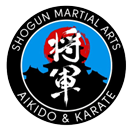Affiliation
Shogun karate is a member of the International Uechi-ryu Karate Federation (IUKF).
Founded by Sensei George Mattson, 10th Dan, the IUKF is a non-profit educational organization, solely dedicated to the common good of International Uechi-ryu and is built upon the premise of loyalty, trust and respect between and among students and teachers within Uechi-ryu Karate.
For further information about the IUKF, please see the following links:
History of Uechi-Ryu
Uechi-ryu is a traditional style of Okinawan karate. The founder of Uechi Ryu was Kanbun Uechi (1877–1948), an Okinawan who went to Fuzhou in Fukien Province, China to study martial arts when he was 20 years old. Uechi-ryu means “Style of Uechi” or “School of Uechi”. Kanbun Uechi studied Pangai-noon (half-hard, half-soft) under Shushiwa in the Fujian (a.k.a. Fukien) province of mainland China in the late 19th century and early 20th century.
After studying 10 years under Shushiwa, Kanbun Uechi opened his own school in the province of Nanjing. Two years later, Kanbun Uechi returned to Okinawa, determined never to teach again because one of his Chinese students had killed a neighbour with an open-hand technique in a dispute over land irrigation.
While he was working as a janitor he was persuaded by a co-worker, Ryuyu Tomoyose, to teach again after having been first convinced to show Tomoyose ways of defending himself against different attacks. When his confidence as a teacher was restored, Uechi, with the help of Ryuyu Tomoyose, moved to Wakayama City, Wakayama Prefecture, where, in 1925, he established the Institute of Pangainun-ryu (half-hard half-soft) Todi-jutsu, and opened a dojo to the public. Eventually, in 1940, his Okinawan students renamed the system as “Uechi Ryu”
Early history
Kanbun Uechi studied Pangai-noon (half-hard, half-soft) under Shushiwa in the Fujian (a.k.a. Fukien) province of mainland China in the late 19th century and early 20th century.
After studying 10 years under Shushiwa, Kanbun Uechi opened his own school in the province of Nanjing. Two years later, Kanbun Uechi returned to Okinawa, determined never to teach again because one of his Chinese students had killed a neighbour with an open-hand technique in a dispute over land irrigation.
While he was working as a janitor he was persuaded by a co-worker, Ryuyu Tomoyose, to teach again after having been first convinced to show Tomoyose ways of defending himself against different attacks.
When his confidence as a teacher was restored, Uechi, with the help of Ryuyu Tomoyose, moved to Wakayama City, Wakayama Prefecture, where, in 1925, he established the Institute of Pangainun-ry? (half-hard half-soft) Todi-jutsu, and opened a dojo to the public. Eventually, in 1940, his Okinawan students renamed the system as “Uechi-Ryu”.
Kanbun Uechi’s son, Kanei Uechi, taught the style at the Futenma City Dojo, Okinawa, and was considered the first Okinawan to sanction teaching foreigners. One of Kanbun’s students, Ryuko Tomoyose, taught a young American serviceman named George Mattson who authored several books on the subject and is largely responsible for popularizing the style in America.
Uechi-Ryu emphasizes toughness of body with quick blows and kicks. Some of the more distinctive weapons of Uechi practitioners are the one-knuckle punch (shoken), spearhand (nukite), and the toe kick (sokusen geri). On account of this emphasis on simplicity, stability, and a combination of linear and circular movements, proponents claim the style is more practical for self-defense than most other martial arts.
In contrast to the more linear styles of karate based on Okinawan Shuri-te or Tomari-te, Uechi-Ryu’s connection with Chinese Nanpa Shorin-ken means the former shares a similar foundation with Naha-Te (and thus with Goju-ryu) despite their separate development.[2] Thus, Uechi-Ryu is also heavily influenced by the circular motions which belong to the kung fu from Fujian province. Uechi-Ryu is principally based on the movements of 3 animals: the Tiger, the Dragon, and the Crane.




